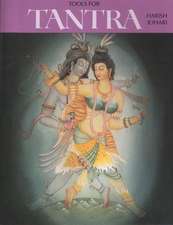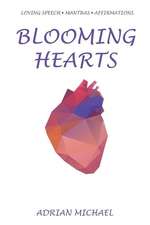Spiritual Traditions of India Coloring Book
Autor Harish Joharien Limba Engleză Paperback – 3 noi 2016
Containing 40 coloring illustrations, the book includes chakra imagery, power yantras, planets, and scenes of Hindu gods and goddesses, such as Ganesh, Hanuman, Shiva, and Parvati. Coloring the chakras enables you to visualize the energy centers in your own body, enhancing your ability to open the chakras and balance your flow of energy. Coloring the power yantras allows you to align your mind and spirit with the energies of good health, tolerance, prosperity, peace, and love, attracting these virtues to your life. Coloring the planets, gods, and goddesses allows you to connect with these powerful entities, inviting their help and influence in your life.
Preț: 52.75 lei
Preț vechi: 69.09 lei
-24% Nou
Puncte Express: 79
Preț estimativ în valută:
10.10€ • 10.43$ • 8.40£
10.10€ • 10.43$ • 8.40£
Carte disponibilă
Livrare economică 07-19 martie
Livrare express 18-22 februarie pentru 39.21 lei
Preluare comenzi: 021 569.72.76
Specificații
ISBN-13: 9781620556290
ISBN-10: 1620556294
Pagini: 96
Ilustrații: 42 b&w illustrations and 2 color images
Dimensiuni: 216 x 279 x 13 mm
Greutate: 0.31 kg
Editura: Inner Traditions/Bear & Company
Colecția Destiny Books
ISBN-10: 1620556294
Pagini: 96
Ilustrații: 42 b&w illustrations and 2 color images
Dimensiuni: 216 x 279 x 13 mm
Greutate: 0.31 kg
Editura: Inner Traditions/Bear & Company
Colecția Destiny Books
Notă biografică
Harish Johari (1934-1999) was a distinguished North Indian author, Tantric scholar, poet, musician, composer, artist, and gemologist who held degrees in philosophy and literature and made it his life’s work to introduce the culture of his homeland to the West. He is the author of many books, including Numerology, Tools for Tantra, and the bestselling Chakras.
Extras
About the Author and the Illustrations
Harish Johari (1934-1999) was a distinguished North Indian author, Tantric scholar, gemologist, poet, musician, composer, painter, and sculptor who held degrees in philosophy and literature and made it his life’s work to introduce the culture of his homeland to the West. He authored 12 books on Eastern spirituality, including Tools for Tantra, Chakras, Numerology, The Planet Meditation Kit, and Ayurvedic Healing Cuisine, and he created the illustrations that accompanied each of them.
The painting tradition founded by Harish is a combination of the overall spiritual Indian art traditions and the special wash painting technique that he learned from his teacher Shri Chandra Bal, who himself learned it from Shri Bhawani Prasad Mittal, who learned it at Shanti Niketan.
The style of the figures is a mixture of three existing forms of Indian artwork that can be found in the painted or sculptured art forms in temples throughout India.
The faces--specifically the eyes, nose, and lips--and the hands and feet are drawn in the style of the paintings located in the Ajanta caves. They represent a two-thousand-year-old fresco style of artwork.
The proportions used in the figures are like those of the sculptures in the Elephanta caves near Bombay. These proportions were chosen because they are so beautiful and delicate, unlike the proportions found in the Ajanta cave paintings, which are very heavy and result in dwarflike figures. The sculptures in the Elephanta caves represent a style that is thousands of years older than the familiar Rajasthan style of artwork that is generally recognized as Indian art.
The postures and movements are inspired by the ancient sculptures of the Ellora caves and the Khajoraho temple because of the grace, preciseness, and expressiveness that these sculptures exemplify.
Another important feature of the artwork is the rich use of hand postures. There are not more than ten hand postures that are generally drawn by artists throughout the world. Indian art, however, uses as many as sixty-four hand postures, reflecting the sixty-four hand postures used in Indian dance rituals and worship. These hand postures, or mudras, have their own symbolism and language and are used as a way to express emotions. The richness that is found in the hand postures of Indian art is a gift to the entire world. The artwork uses these hand postures as a language of the heart as opposed to the language of the head.
The images can evoke spiritual feelings in the viewers, while for those that use the illustrations as objects of meditation, the images can become a vehicle for spiritual contact with the divine beings.
As Harish said of the subjects of Indian spiritual art, “science is very beautifully explained in Indian iconography; the entire science of physics, the science of psychology, the science of sociology, interpersonal relationships . . . all these things are interwoven in Indian painting and in mythology.”
Harish Johari (1934-1999) was a distinguished North Indian author, Tantric scholar, gemologist, poet, musician, composer, painter, and sculptor who held degrees in philosophy and literature and made it his life’s work to introduce the culture of his homeland to the West. He authored 12 books on Eastern spirituality, including Tools for Tantra, Chakras, Numerology, The Planet Meditation Kit, and Ayurvedic Healing Cuisine, and he created the illustrations that accompanied each of them.
The painting tradition founded by Harish is a combination of the overall spiritual Indian art traditions and the special wash painting technique that he learned from his teacher Shri Chandra Bal, who himself learned it from Shri Bhawani Prasad Mittal, who learned it at Shanti Niketan.
The style of the figures is a mixture of three existing forms of Indian artwork that can be found in the painted or sculptured art forms in temples throughout India.
The faces--specifically the eyes, nose, and lips--and the hands and feet are drawn in the style of the paintings located in the Ajanta caves. They represent a two-thousand-year-old fresco style of artwork.
The proportions used in the figures are like those of the sculptures in the Elephanta caves near Bombay. These proportions were chosen because they are so beautiful and delicate, unlike the proportions found in the Ajanta cave paintings, which are very heavy and result in dwarflike figures. The sculptures in the Elephanta caves represent a style that is thousands of years older than the familiar Rajasthan style of artwork that is generally recognized as Indian art.
The postures and movements are inspired by the ancient sculptures of the Ellora caves and the Khajoraho temple because of the grace, preciseness, and expressiveness that these sculptures exemplify.
Another important feature of the artwork is the rich use of hand postures. There are not more than ten hand postures that are generally drawn by artists throughout the world. Indian art, however, uses as many as sixty-four hand postures, reflecting the sixty-four hand postures used in Indian dance rituals and worship. These hand postures, or mudras, have their own symbolism and language and are used as a way to express emotions. The richness that is found in the hand postures of Indian art is a gift to the entire world. The artwork uses these hand postures as a language of the heart as opposed to the language of the head.
The images can evoke spiritual feelings in the viewers, while for those that use the illustrations as objects of meditation, the images can become a vehicle for spiritual contact with the divine beings.
As Harish said of the subjects of Indian spiritual art, “science is very beautifully explained in Indian iconography; the entire science of physics, the science of psychology, the science of sociology, interpersonal relationships . . . all these things are interwoven in Indian painting and in mythology.”
Descriere
Balance your chakras, enhance health and prosperity, and connect with the gods and goddesses through meditative coloring


















